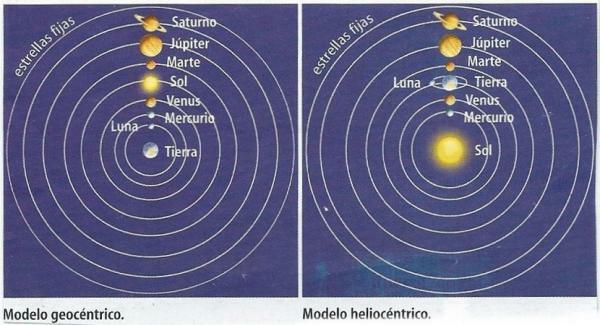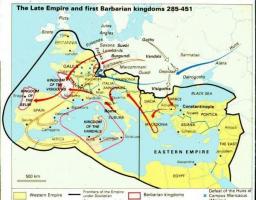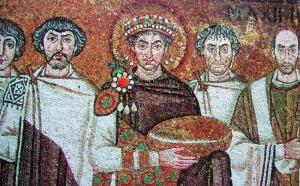Discover the DIFFERENCES between heliocentrism and geocentrism

Image: Microsiervos
In this lesson from a TEACHER, we will explain the differences between heliocentrism and geocentrism, two theories that explain the situation of the Earth with respect to the universe, but in totally opposite ways. The geocentrism, is the oldest of all and linked to religion, and states that the earth is an immobile planet located in the center of the universe and that the sun and the rest of the planets revolve around it. The heliocentrism, develops from the sixteenth century, with Copernicus, although it is true that Aristarchus, who died around 230 BC, already stated that the earth, like the other planets, moved around the sun.
The heliocentric theory.
Geocentrism and heliocentrism are two theories that differ greatly. Next, we will talk about the heliocentric system and its defenders.
Aristarchusfrom Samos, in front of Aristotle and Ptolemy, he was the first to defend the heliocentric theory, an idea that was later picked up by the Pythagoreans. Unfortunately from the studies of the Greek physicist nothing has remained. All we know is through
Plutarch and Archimedes, who wrote in relation to Aristarchus' theory:… that the fixed stars and the Sun remain immobile, that the Earth revolves around the Sun in the circumference of a circle, the Sun lies in the center of the orbit, and that the sphere of the fixed stars, situated with almost the same center as the Sun, is so large that the circle in the which he supposes that the Earth rotates has such proportion to the distance of the fixed stars as the center of the sphere keeps surface.
With the destruction of the library of alexandria much of the classical thought disappears. Everything that sounds like science, then begins to be persecuted by Christianity and superstition takes over the world. Geocentrism is the only theory acceptable to the Church.
But the fifteenth century, Nicolaus Copernicus, father of modern astronomy, he dared to confront the power of the Church by stating that the Earth and the rest of the planets revolve around the sun, and not the other way around. De Revolutionibus Orbium Coelestium, marks a true turning point and a paradigm shift that is known as the Copernican Revolution.
Copernicus theory
And it is that the physicist finds too many flaws in the Ptolemaic system. To begin with, through observation, it can be seen that the movements of the orbits of the planets are not circular but elliptical. But Ptolemy denies them by offering a most bizarre explanation: the planets describe perfectly circular orbits around a central point, which in turn moves around the Land. This eccentric movement would explain according to Ptolemy that they look like elliptical orbits when in fact they are circular.
So, Copernicus defends his idea before the scientific community and the Church throws its hands at its head, although unlike other later scientists such as Giordano Bruno and Galileo Galilei, he was not a victim of the abuses of the Holy Inquisition. Of the latter, it is said that before after denying heliocentrism before this court, he affirmed: E pur si muove, or what is the same, "and yet it moves."
Kepler's proposal and its laws
Kepler, finds some errors in the Copernican model, such as the uniformity of motion and formulates its 3 laws of planetary motion:
- 1st Law. All the planets move around the Sun describing elliptical orbits, the Sun being one of the foci of the ellipse
- 2nd Law. The radius vector that joins each planet with the Sun travels equal spaces in equal times.
- 3rd Law. The square of the orbital period of a planet is directly proportional to the cube of the length of the mean distance of its elliptical orbit.
In XVII century, Newton, formulates the law of universal gravitation, and already in the twentieth century, Albert Einstein discloses the theory of relativity, the basis of current physics.

Image: Meteorology Network
Geocentric theory: simple definition.
We continue this lesson with the differences between heliocentrism and geocentrism to talk about this second theory.
The geocentric system is very influenced by religious ideas and the defense of the privileged situation of the Earth with respect to the other planets, in the center of the Universe. The founder of this theory was Ptolemy and was the dominant model throughout Middle Ages and enjoyed the recognition of the Church.
According to the geocentric model, Earth occupies the center of the universe, the sun and the rest of the planets revolve around it. Let's see next which thinkers defended this theory.
Anaximander of Miletus, in the 6th century BC, defends the idea that the Earth is cylindrical and floats in the center of the spheres and that the sun, and the rest of the planets, move around it. Therefore, he proposed a cosmology in which the Earth was shaped like a section of a pillar (a cylinder) floating at the center of everything. For its part, the Pythagorean school affirmed that the Earth was spherical, although they denied its central position in the universe. The Earth, for the Pythagoreans, revolves around an invisible fire.
In order to Plato, the Earth has a spherical shape and is at the center of the universe, and the stars and other planets revolve around it. Instead, Aristotle, following Eudoxus, postulates that the Earth is spherical and is at the center of the universe, surrounded by spheres concentric, which move in a uniform motion to maintain the dynamism of the planets revolving around the earth.
Ptolemy's proposal
Ptolemy, criticizes the model of Eudoxus, since his theory of concentric spheres could not explain the distance changes of the planets. On the other hand, the model that Ptolemy describes in his work, the Almagest, does seem to achieve it and in fact, it was the Theory accepted throughout the Middle Ages.
According to this model, the planets are moved by two or more spheres: a deferent sphere whose center is the Earth, and the epicycle at the center of the deferent sphere. The planets would be in the center of the epicycle and the deferent sphere revolves around the earth. The epicycle also rotates which causes the distances of the planets with respect to the Earth. The planetary order in the Ptolemaic system is Earth, Moon, Mercury, Venus, Sun, Mars, Jupiter, Saturn, and the fixed stars.
Now you know the differences between heliocentrism and geocentrism, therefore, you can better understand the different theories that have existed about the universe.
If you want to read more articles similar to Heliocentrism and Geocentrism: differences, we recommend that you enter our category of Philosophy.
Bibliography
Milenko Bernadic Cvitkovic, Juan Carlos Gorostizaga Aguirre. And yet it does not move. Ed. Red Point.
Giovani Reale and Dario Antíseri. History of Philosophy. Ed. San Pablo



